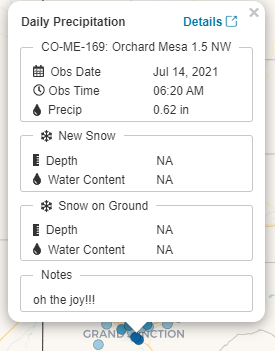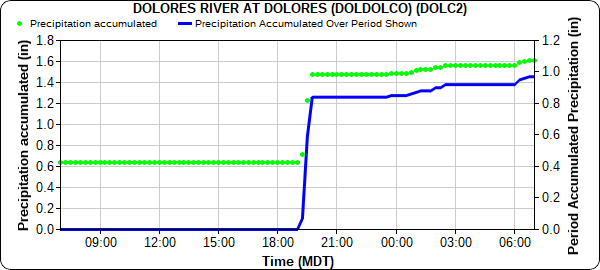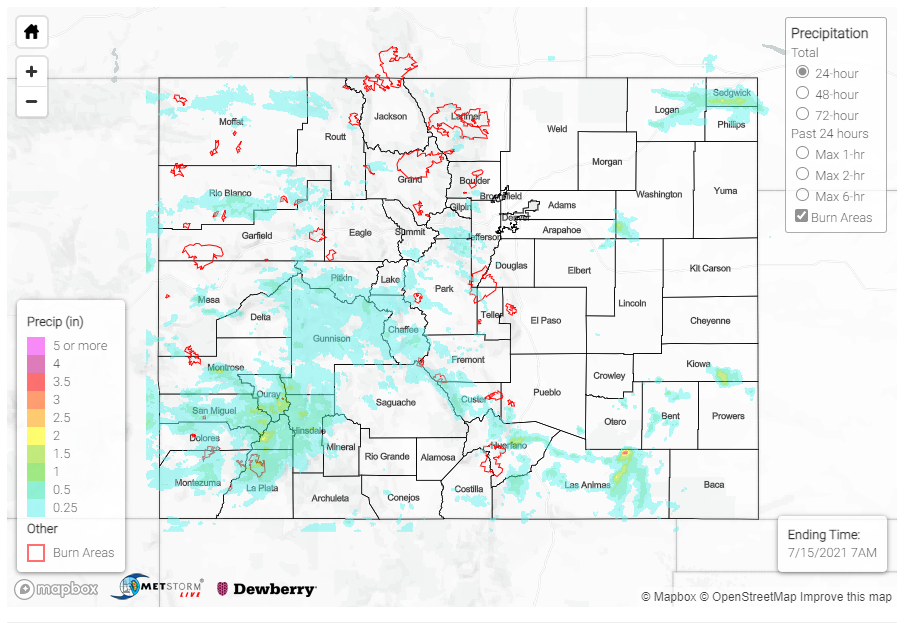Issue Date: Wednesday, July 14, 2021
Issue Time: 9:45 AM MDT
Summary:
Monsoon season has arrived, bringing with it widespread rainfall, even heavy at times, to much of the state! However, the real winners yesterday were in the Southwest Slope, San Juan and Central Mountains, and Grand Valley.
Tuesday began with an early morning, weak cold-front and associated low-pressure situated in Northeast Colorado – Southwest Nebraska, which pushed eastward out of the state with scattered, light rainfall across the Northeast Plains. By early afternoon, thunderstorms began filling in at the high elevations in the Northern, Central, Front Range, and San Juan Mountains, and then filled in to the Northwest and Southwest Slopes and Grand Valley as the afternoon progressed. The moisture just kept coming and continued to rain off and on for most the day in the southwest, bringing joy to many CoCoRaHS observers based on remarks on their daily reports.
As rainfall picked up, flood warnings and advisories were issued across the state, in addition to severe thunderstorm warnings for damaging winds and large hail. Wind gusts between 45-63 mph were ultimately recorded from storms across the Northwestern and Southwestern Slopes, Grand Valley, and Central Mountains. Many of the flash flood warnings were for previous burn areas. These include: The Decker burn scar and Poncha Pass – which closed earlier this month from debris flows, the Grizzly Creek burn scar – which closed I-70 in Glenwood Canyon to traffic again for several hours, and the Hayden Pass burn scar. Thankfully no additional flooding was reported on these scars.
Some notable rainfall totals across the Southwest Slope and San Juan Mountains:
- A COOP observer in Gateway, on the CO-UT border, reported 1.00 inch in just 20 minutes! The 30-minute, 25-year ARI from NOAA Atlas 14 at this location is 0.94 inches, so Gateway saw just over a 25-year event!
- 0.98 in was observed on the south end of Grand Junction, most of that also falling in an hour around 4:00 pm.

- The Dolores River at Dolores station picked up 0.97 inches with most of that, 0.84 inches, falling within a 45-minute period after 7 pm.

- A CoCoRaHS observer in Chromo, just north of the New Mexico border in Archuleta County, reported 0.95 inches.
- A public report from Telluride came in at 0.78 inches.
- Heavy rain was reported in Ouray, with a total of 0.71 inches from one CoCoRaHS observer. Minor street flooding was also reported there from a nearby CoCoRaHS observer, who also reported 0.69 inches of rain.
- And finally, a CoCoRaHS observer in Silverton reported 0.60 inches and said it was a “Great day with constant rumbles of thunder and steady rain”.
Rainfall totals along the Urban Corridor, Palmer Ridge, Eastern Plains were less than 0.25 inches aside from a few cells, including a line of storms along the I-76 corridor on the Northeast Plains. The day ended with a general clearing out overnight, until another late night-early morning system entered the state from the southwest, bumping up Southwest Slope and Grand Valley accumulations with additional modest rainfall.
For rainfall estimates in your area, check out the State Precipitation Map below!
Click Here For Map Overview
Note: The 24-hour, 48-hour and 72-hour total precipitation do not contain bias corrections today due to errors in the CoCoRaHS data. This means there may be underestimations in QPE over the southwest and southeast corners of the state.



